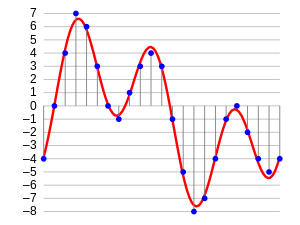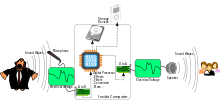Digital audio

Digital audio is technology that can be used to record, store, generate, manipulate, and reproduce sound using audio signals that have been encoded in digital form. Following significant advances in digital audio technology during the 1970s, it gradually replaced analog audio technology in many areas of sound production, sound recording (tape systems were replaced with digital recording systems), sound engineering and telecommunications in the 1990s and 2000s.
A microphone converts sound (a singer's voice or the sound of an instrument playing) to an analog electrical signal, then an analog-to-digital converter (ADC)—typically using pulse-code modulation—converts the analog signal into a digital signal. This digital signal can then be recorded, edited and modified using digital audio tools. When the sound engineer wishes to listen to the recording on headphones or loudspeakers (or when a consumer wishes to listen to a digital sound file of a song), a digital-to-analog converter performs the reverse process, converting a digital signal back into an analog signal, which analog circuits amplify and send to a loudspeaker.
Digital audio systems may include compression, storage, processing and transmission components. Conversion to a digital format allows convenient manipulation, storage, transmission and retrieval of an audio signal. Unlike analog audio, in which making copies of a recording leads to degradation of the signal quality, when using digital audio, an infinite number of copies can be made without any degradation of signal quality.
Overview

Digital audio technologies in the 2010s are used in the recording, manipulation, mass-production, and distribution of sound, including recordings of songs, instrumental pieces, podcasts, sound effects, and other sounds. Modern online music distribution depends on digital recording and data compression. The availability of music as data files, rather than as physical objects, has significantly reduced the costs of distribution.[1] Before digital audio, the music industry distributed and sold music by selling physical copies of albums in the form of records, tapes, and then CDs. With digital audio and online distribution systems such as iTunes, companies sell digital sound files to consumers, which the consumer receives over the Internet. This digital audio/Internet distribution model is much less expensive than producing physical copies of recordings, packaging them and shipping them to stores.
An analog audio system captures sounds, and converts their physical waveforms into electrical representations of those waveforms by use of a transducer, such as a microphone. The sounds are then stored, as on tape, or transmitted. The process is reversed for playback: the audio signal is amplified and then converted back into physical waveforms via a loudspeaker. Analog audio retains its fundamental wave-like characteristics throughout its storage, transformation, duplication, and amplification.
Analog audio signals are susceptible to noise and distortion, due to the innate characteristics of electronic circuits and associated devices. Disturbances in a digital system do not result in error unless the disturbance is so large as to result in a symbol being misinterpreted as another symbol or disturb the sequence of symbols. It is therefore generally possible to have an entirely error-free digital audio system in which no noise or distortion is introduced between conversion to digital format, and conversion back to analog.
A digital audio signal may be encoded for correction of any errors that might occur in the storage or transmission of the signal, but this is not strictly part of the digital audio process. This technique, known as "channel coding", is essential for broadcast or recorded digital systems to maintain bit accuracy. The discrete time and level of the binary signal allow a decoder to recreate the analog signal upon replay. Eight to Fourteen Bit Modulation is a channel code used in the audio Compact Disc (CD).
Conversion process

A digital audio system starts with an ADC that converts an analog signal to a digital signal.[note 1] The ADC runs at a specified sampling rate and converts at a known bit resolution. CD audio, for example, has a sampling rate of 44.1 kHz (44,100 samples per second), and has 16-bit resolution for each stereo channel. Analog signals that have not already been bandlimited must be passed through an anti-aliasing filter before conversion, to prevent the distortion that is caused by audio signals with frequencies higher than the Nyquist frequency, which is half of the system's sampling rate.
A digital audio signal may be stored or transmitted. Digital audio can be stored on a CD, a digital audio player, a hard drive, a USB flash drive, or any other digital data storage device. The digital signal may then be altered through digital signal processing, where it may be filtered or have effects applied. Audio data compression techniques, such as MP3, Advanced Audio Coding, Ogg Vorbis, or FLAC, are commonly employed to reduce the file size. Digital audio can be streamed to other devices.
For playback, digital audio must be converted back to an analog signal with a DAC. DACs run at a specific sampling rate and bit resolution, but may use oversampling, upsampling or downsampling to convert signals that have been encoded with a different sampling rate.
History in commercial recording
Pulse-code modulation was invented by British scientist Alec Reeves in 1937[2] and was used in telecommunications applications long before its first use in commercial broadcast and recording. Commercial digital recording was pioneered in Japan by NHK and Nippon Columbia, also known as Denon, in the 1960s. The first commercial digital recordings were released in 1971.[3]
The BBC also began to experiment with digital audio in the 1960s. By the early 1970s it had developed a 2-channel recorder, and in 1972 it deployed a digital audio transmission system that linked their broadcast center to their remote transmitters.[3]
The first 16-bit PCM recording in the United States was made by Thomas Stockham at the Santa Fe Opera in 1976, on a Soundstream recorder. An improved version of the Soundstream system was used to produce several classical recordings by Telarc in 1978. The 3M digital multitrack recorder in development at the time was based on BBC technology. The first all-digital album recorded on this machine was Ry Cooder's Bop till You Drop in 1979. British record label Decca began development of its own 2-track digital audio recorders in 1978 and released the first European digital recording in 1979.[3]
.jpg)
Popular digital multitrack recorders produced by Sony and Mitsubishi in the early 1980s helped to bring about digital recording's acceptance by the major record companies. The 1982 introduction of the CD popularized digital audio with consumers.[3]
Technologies
- Digital audio broadcasting
- Digital Audio Broadcasting (DAB)
- HD Radio
- Digital Radio Mondiale (DRM)
- In-band on-channel (IBOC)
- Storage technologies
- Digital audio player
- Digital Audio Tape (DAT)
- Digital Compact Cassette (DCC)
- Compact Disc (CD)
- Hard disk recorder
- DVD-Audio
- MiniDisc
- Super Audio CD
- Blu-ray Disc (BD)
- Various audio file formats
Digital audio interfaces
Audio-specific interfaces include:
- AC'97 (Audio Codec 1997) interface between Integrated circuits on PC motherboards
- Intel High Definition Audio A modern replacement for AC'97
- ADAT interface
- AES3 interface with XLR connectors
- AES47, Professional AES3-style digital audio over Asynchronous Transfer Mode networks
- I²S (Inter-IC sound) interface between Integrated circuits in consumer electronics
- MADI Multichannel Audio Digital Interface
- MIDI low-bandwidth interconnect for carrying instrument data; cannot carry sound but can carry digital sample data in non-realtime
- S/PDIF, either over coaxial cable or TOSLINK
- TDIF, TASCAM proprietary format with D-sub cable
- A2DP via Bluetooth
Naturally, any digital bus can carry digital audio. Also, several interfaces are engineered to carry digital video and audio together, including HDMI and DisplayPort.
In professional architectural or installation applications, many digital audio networking protocols and interfaces exist.
See also
Notes
- ↑ Some audio signals such as those created by digital synthesis originate entirely in the digital domain, in which case analog to digital conversion does not take place.
References
- ↑ Janssens, Jelle; Stijn Vandaele; Tom Vander Beken (2009). "The Music Industry on (the) Line? Surviving Music Piracy in a Digital Era". European Journal of Crime 77 (96). doi:10.1163/157181709X429105.
- ↑ Genius Unrecognised, BBC, 2011-03-27, retrieved 2011-03-30
- 1 2 3 4 Fine, Thomas (2008). Barry R. Ashpole, ed. "The Dawn of Commercial Digital Recording" (PDF). ARSC Journal (Ted P. Sheldon). Retrieved 2010-05-02.
Further reading
- Borwick, John, ed., 1994: Sound Recording Practice (Oxford: Oxford University Press)
- Bosi, Marina, and Goldberg, Richard E., 2003: Introduction to Digital Audio Coding and Standards (Springer)
- Ifeachor, Emmanuel C., and Jervis, Barrie W., 2002: Digital Signal Processing: A Practical Approach (Harlow, England: Pearson Education Limited)
- Rabiner, Lawrence R., and Gold, Bernard, 1975: Theory and Application of Digital Signal Processing (Englewood Cliffs, New Jersey: Prentice-Hall, Inc.)
- Watkinson, John, 1994: The Art of Digital Audio (Oxford: Focal Press)
External links
| Wikimedia Commons has media related to Digital audio. |
- Monty Montgomery (2012-10-24). "Guest Opinion: Why 24/192 Music Downloads Make No Sense". evolver.fm. Retrieved 2012-12-07.
- J. ROBERT STUART. "Coding High Quality Digital Audio" (PDF). Retrieved 2012-12-07.
- Dan Lavry. "Sampling Theory For Digital Audio" (PDF). Retrieved 2012-12-07.
| ||||||||||||||||||||||||||||||||||||||||||||||||||||||||||||||||
| ||||||||||||||||||||||
| ||||||||||||||||||||||||||||||||||||||||||